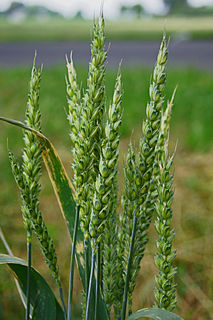
The Poales are a large order of flowering plants in the monocotyledons, and includes families of plants such as the grasses, bromeliads, and sedges. Sixteen plant families are currently recognized by botanists to be part of Poales.

Forsythia, is a genus of flowering plants in the olive family Oleaceae. There are about 11 species, mostly native to eastern Asia, but one native to southeastern Europe. Forsythia – also one of the plant's common names – is named after William Forsyth.
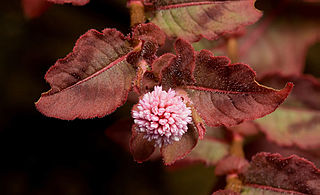
Persicaria is a genus of herbaceous flowering plants in the knotweed family, Polygonaceae. Plants of the genus are known commonly as knotweeds or smartweeds. It has a cosmopolitan distribution, with species occurring nearly worldwide. The genus was segregated from Polygonum.
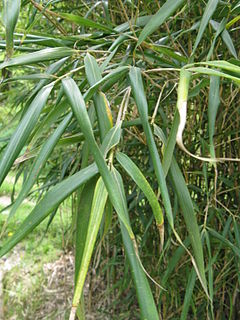
Pleioblastus is an East Asian genus of monopodial bamboos in the grass family Poaceae. They are native to China and Japan, and naturalized in scattered places in Korea, Europe, New Zealand, and the Western Hemisphere.

Shibataea is a genus of Chinese bamboos in the grass family.
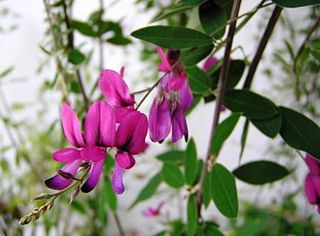
Lespedeza is a genus of some 40 species of flowering plants in the pea family (Fabaceae), commonly known as bush clovers or Japanese clovers (hagi). The genus is native to warm temperate to subtropical regions of eastern North America, eastern and southern Asia and Australasia.

Jungermanniales is the largest order of liverworts. They are distinctive among the liverworts for having thin leaf-like flaps on either side of the stem. Most other liverworts are thalloid, with no leaves.
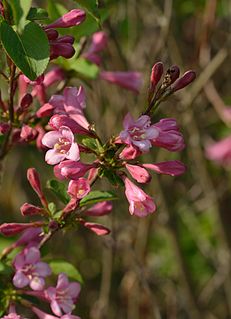
Weigela is a genus of between six and 38 species of deciduous shrubs in the family Caprifoliaceae, growing to 1–5 m (3–15′) tall. All are natives of eastern Asia. The genus is named after the German scientist Christian Ehrenfried Weigel.

Jungermanniopsida is the largest of three classes within the division Marchantiophyta (liverworts).

Staphylea, called bladdernuts, is a small genus of 10 or 11 species of flowering plants in the family Staphyleaceae, native to temperate regions of the Northern Hemisphere. The highest species diversity is in China, where four species occur.

Takenoshin Nakai was a Japanese botanist. In 1919 and 1930 he published papers on the plants of Japan and Korea, including the genus Cephalotaxus.

Watermelon is a flowering plant species of the Cucurbitaceae family. A scrambling and trailing vine-like plant, it was originally domesticated in Africa. It is a highly cultivated fruit worldwide, with more than 1,000 varieties.

Liparis loeselii, the fen orchid, yellow widelip orchid, or bog twayblade, is a species of orchid. It is native to Europe, northern Asia, the eastern United States, and eastern Canada. It grows in fens, bogs and dune slacks. It has yellow flowers and glossy yellow-green leaves.
- Liparis loeselii subsp. loeselii - Europe, Russia, Kazakhstan, Canada, United States
- Liparis loeselii subsp. orientalisEfimov - Altay region of Russia
- Liparis loeselii subsp. sachalinensis(Nakai) Efimov - Sakhalin Island in Russia
The APG III system of flowering plant classification is the third version of a modern, mostly molecular-based, system of plant taxonomy being developed by the Angiosperm Phylogeny Group (APG). Published in 2009, it was superseded in 2016 by a further revision, the APG IV system.
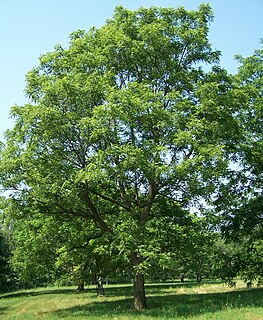
Jugandoideae is a subfamily of the walnut family Juglandaceae.

Bistorta is a genus of flowering plants in the family Polygonaceae. As of February 2019 about 40 species are accepted. It has been supported as a separate clade by molecular phylogenetic analysis. Bistorta species are native throughout much of the Northern Hemisphere, as far south as Mexico in North America and Thailand in Asia.
The APG IV system of flowering plant classification is the fourth version of a modern, mostly molecular-based, system of plant taxonomy for flowering plants (angiosperms) being developed by the Angiosperm Phylogeny Group (APG). It was published in 2016, seven years after its predecessor the APG III system was published in 2009, and 18 years after the first APG system was published in 1998. In 2009, a linear arrangement of the system was published separately; the APG IV paper includes such an arrangement, cross-referenced to the 2009 one.

Arctous is a genus of plants referred to by the common name "bearberry", a name sometimes shared with certain species of the related genus Arctostaphylos, in particular, A. uva-ursi. Although the two genera are related, certain characters, such as deciduous, marcescent leaves, rugose-reticulate venation, and finely-toothed leaves are more typical of Arctous than Arctostaphylos.
Hisao Migo was a Japanese botanist.

Protea canaliculata, also known as the groove-leaf sugarbush, is a species of flowering shrub of the genus Protea, which is endemic to the Cape Provinces of South Africa.

















